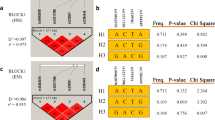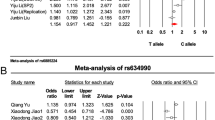Abstract
This study looks at novel variants of the TGFβ1 gene and their potential association with high myopia in an ethnic population from Kashmir, India. Allele frequencies of 247 Kashmiri subjects (from India) with high myopia and 176 ethnically matched healthy controls were tested for Hardy–Weinberg disequilibrium. The genotype and allele frequencies were evaluated using chi-square or Fisher’s exact tests. One of the three SNPs in codon 10 showed a significant difference between patients and control subjects (rs1982073: p genotype = 0.003, p allele = 0.001). There were no statistically significant differences between patients and control subjects for the other two SNPs, rs1800471 at codon 25 and a novel variant at codon 52. SNP rs1982073, substituting proline with leucine, appeared to be significantly associated with high myopia (p < 0.05). In silico predictions show that substitutions are likely to have an impact on the structure and functional properties of the protein, making it imperative to understand their functional consequences in relation to high myopia.

Similar content being viewed by others
References
Ahmed I, Mian S, Mudasir S, Andrabi KI (2008) Prevalence of myopia in students of Srinagar city of Kashmir, India. Int J Health Sci 2(1):77–81
Andrew IJ, Nguyen M, Gentle A (2004) Isoform-specific changes in scleral transforming growth factor-expression and the regulation of collagen synthesis during myopia progression. J Biol Chem 18:18121–18126
Blesa JR, Prieto-Ruiz JA, Hernandez-Yago J (2004) Conformation-sensitive gel electrophoresis as an ideal high-throughput strategy for accurate detection of sequence variations in DNA: screening hTomm and hTimm genes. J Biomol Screen 9:7
Camacho CJ, Gatchell DW (2003) Successful discrimination of protein interactions. Proteins Struct Funct Genet 52:92–97
Camacho CJ, Gatchell DW, Kimura SR, Vajda S (2000) Scoring docked conformations generated by rigid body docking. Proteins Struct Funct Genet 40:525–537
Chen F, Ogawa K, Nagarajan RP, Zhang M, Kuang C, Chen Y (2003) Regulation of TG-interacting factor by transforming growth factor-beta. Biochem J 371:257–263
Chow YC, Dhillon B, Chew PT, Chew SJ (1990) Refractive errors in Singapore medical students. Singap Med J 31:472–473
Comeau SR, Gatchell DW, Vajda S, Camacho CJ (2004) ClusPro: an automated docking and discrimination method for the prediction of protein complexes. Bioinformatics 20:45–50
Curtin BJ (1970) Myopia: a review of its etiology, pathogenesis, and treatment. Surv Ophthalmol 15:1–17
Fledelius HC (1988) Myopia prevalence in Scandinavia: a survey, with emphasis on factors of relevance for epidemiological refraction studies in general. Acta Ophthalmol 185:44–50
Ganguly A, Matthew JR, Darwin JP (1993) Conformation-sensitive gel electrophoresis for rapid detection of single-base differences in double-stranded PCR products and DNA fragments: evidence for solvent-induced bends in DNA heteroduplexes. Proc Natl Acad Sci 90:10325–10329
Guggenheim JA, McBrien NA (1996) Form-deprivation myopia induces activation of scleral matrix metalloproteinase-2 in tree shrew. Invest Ophthalmol Vis Sci 37:1380–1395
Guggenheim JA, Hill C, Yam TF (2003) Myopia, genetics, and ambient lighting at night in a UK sample. Br J Ophthalmol 87(5):580–582
Gwiazda J, Ong E, Held R, Thorn F (2000) Myopia and ambient night-time lighting. Nature 404(6774):144
Hammond CJ, Andrew T, Mak YT, Spector TD (2004) A susceptibility locus for myopia in the normal population is linked to the PAX6 gene region on chromosome 11: a genomewide scan of dizygotic twins. Am J Hum Genet 75:294–304
Hayashi T, Inoko H, Nishizaki R, Ohno S, Mizuki N (2007) Exclusion of transforming growth factor-β1 as a candidate gene for myopia in the Japanese. Jpn J Ophthalmol 51(2):96–99
Honda S, Fujii S, Sekiya Y, Yamamoto M (1996) Retinal control on the axial length mediated by transforming growth factor-beta in chick eye. Invest Ophthalmol Vis Sci 37:2519–2526
Ibay G, Doan B, Reider L, Dana D, Schlifka M, Hu H, Holmes T, O’Neill J, Owens R, Ciner E, Bailey-Wilson JE, Stambolian D (2004) Candidate high myopia loci on chromosomes 18p and 12q do not play a major role in susceptibility to common myopia. BMC Med Genet 5:20
Inamori Y, Ota M, Inoko H, Okada E, Nishizaki R, Shiota T, Mok J, Oka A, Ohno S, Mizuki N (2007) The COL1A1 gene and high myopia susceptibility in Japanese. Hum Genet 122:151–157
Jobling AI, Nguyen M, Gentle A, McBrien NA (2004) Isoform-specific changes in scleral transforming growth factor-beta expression and the regulation of collagen synthesis during myopia progression. J Biol Chem 279:18121–18126
Kusakari T, Sato T, Tokoro T (2001) Visual deprivation stimulates the exchange of the fibrous sclera into the cartilaginous sclera in chicks. Exp Eye Res 73:533–546
Lam DSC, Lee WS, Leung YF, Tam POS, Fan DSP, Fan BJ, Pang CP (2003) TGF-beta-induced factor: a candidate gene for high myopia. Invest Ophthalmol Vis Sci 44:1012–1015
Larkin MA, Blackshields G, Brown NP, Chenna R, McGettigan PA, McWilliam H, Valentin F, Wallace IM, Wilm A, Lopez R, Thompson JD, Gibson TJ, Higgins DG (2007) Clustal W and Clustal X version 2.0. Bioinformatics 23(21):2947–2948
Lin HJ, Wan L, Tsai Y, Tsai YY, Fan SS, Tsai CH, Tsai FJ (2006) The TGFβ1 gene codon 10 polymorphism contributes to the genetic predisposition to high myopia. Mol Vis 12:698–703
Lin LL, Chen CJ, Hung PT, Ko LS (1988) Nation-wide survey of myopia among school children in Taiwan. Acta Ophthalmol 185:29–33
McBrien NA, Gentle A (2003) Role of the sclera in the development and pathological complications of myopia. Prog Retin Eye Res 22(3):307–338
Naiglin L, Gazagne C, Dallongeville F, Thalamas C, Idder A, Rascol O, Malecaze F, Calvas P (2002) A genome wide scan for familial high myopia suggests a novel locus on chromosome 7q36. J Med Genet 39:118–124
Overall CM, Wrana JL, Sodek J (1989) Independent regulation of collagenase, 72-kDa progelatinase, and metalloendoproteinase inhibitor expression in human fibroblasts by transforming growth factor β. J Biol Chem 264(3):1860–1869
Paluru PC, Ronan SM, Heon E, Devoto M, Wildenberg SC, Scavello G, Holleschau A, Mäkitie O, Cole WG, King RA, Young TL (2003) New locus for autosomal dominant high myopia maps to the long arm of chromosome 17. Invest Ophthalmol Vis Sci 44:1830–1836
Paluru PC, Nallasamy S, Devoto M, Rappaport EF, Young TL (2005) Identification of a novel locus on 2q for autosomal dominant high grade myopia. Invest Ophthalmol Vis Sci 46:2300–2307
Patel A, Scott WR, Lympany PA, Rippin JD, Gill GV, Barnett AH, Bain SC (2005) The TGF-beta 1 gene codon 10 polymorphism contributes to the genetic predisposition to nephropathy in type 1 diabetes. Diabet Med 22(1):69–73
Quinn GE, Shin CH, Maguire MG, Stone RA (1999) Myopia and ambient lighting at night. Nature 399(6732):113–114
Rada JA, Shelton S, Norton TT (2006) The sclera and myopia. Exp Eye Res 82(2):185–200
Saika S (2006) TGFβ pathobiology in the eye. Lab Invest 86(2):106–115
Sandhya A, Bindu CH, Reddy KP, Vishnupriya S (2011) TGFB1 codon 10 polymorphism and its association with the development of myopia: a case–control study. Biol Med 3(4):18–24
Saw SM, Wu HM, Seet B, Wong TY, Yap E, Chia KS, Stone RA, Lee L (2001) Academic achievement, close up work parameters, and myopia in Singapore military conscripts. Br J Ophthalmol 85(7):855–860
Schwartz M, Haim M, Skarsholm D (1990) X-linked myopia: bornholm eye disease, linkage to DNA markers on the distal part of Xq. Clin Genet 38:281–286
Seko Y, Shimokawa H, Tokoro T (1995) Expression of bFGF and TGFbeta 2 in experimental myopia in chicks. Invest Ophthalmol Vis Sci 36:1183–1187
Song QH, Singh RP, Richardson TP, Nugent MA, Trinkaus-Randall V (2000) Transforming growth factor-beta 1 expression in cultured corneal fibroblasts in response to injury. J Cell Biochem 77:186–199
Stambolian D, Ibay G, Reider L, Dana D, Moy C, Schlifka M, Holmes T, Ciner E, Bailey-Wilson JE (2004) Genomewide linkage scan for myopia susceptibility loci among Ashkenazi Jewish families shows evidence of linkage on chromosome 22q12. Am J Hum Genet 75:448–459
Tanihara H, Yoshida M, Matsumoto M, Yoshimura N (1993) Identification of transforming growth factor-beta expressed in cultured human retinal pigment epithelial cells. Invest Ophthalmol Vis Sci 34(2):413–419
Thompson JD, Gibson TJ, Plewniak F, Jeanmougin F, Higgins DG (1997) The Clustal X windows interface: flexible strategies for multiple sequence alignment aided by quality analysis tools. Nucleic Acids Res 25(24):4876–4882
Tokoro T, Sato A (eds) (1982) Results of investigation of pathologic myopia in Japan: report of myopic chorioretinal atrophy. Ministry of Health and Welfare, Tokyo, pp 32–35
Wang P, Li S, Xiao X, Jia X, Jiao X, Guo X, Qingjiong Zhang Q (2009) High myopia is not associated with SNPs in the TGIF, Lumican, TGFB1 and HGF genes. Invest Ophthalmol Vis Sci 50:4
Wang Q, Klein BEK, Klein R, Moss SE (1994) Refractive status in the Beaver Dam Eye Study. Invest Ophthalmol Vis Sci 35:4344–4347
Wensor M, McCarty CA, Taylor HR (1999) Prevalence and risk factors of myopia in Victoria, Australia. Arch Ophthalmol 117:658–663
Wilson A, Woo G (1989) A review of the prevalence and causes of myopia. Singap Med J 30:479–484
Wojciechowski R, Moy C, Ciner E, Ibay G, Reider L, Bailey-Wilson JE, Stambolian D (2006) Genomewide scan in Ashkenazi Jewish families demonstrates evidence of ocular refraction to a QTL on chromosome 1p36. Hum Genet 119:389–399
Young TL, Ronan SM, Drahozal LA, Wildenberg SC, Alvear AB, Oetting WS, Atwood LD, Wilkin DJ, King RA (1998) Evidence that a locus for familial high myopia maps to chromosome 18p. Am J Hum Genet 63:109–119
Zadnik K (1997) Myopia development in childhood. Optom Vis Sci 74(8):603–608
Zadnik KK, Jones LA, Irvin BC, Kleinstein RN, Manny RE, Shin JA, Mutti DO (2000) Myopia and ambient night-time lighting: CLEERE Study Group, collaborative longitudinal evaluation of ethnicity and refractive error. Nature 404(6774):143–144
Zha Y, Leung KH, Lo KK, Fung WY, Nq PW, Shi MG, Yap MK, Yip SP (2009) TGFβ1 as a susceptibility gene for high myopia: a replication study with new findings. Arch Ophthalmol 127(4):541–548
Zhang Q, Guo X, Xiao X, Jia X, Li S, Hejtmancik JF (2006) Novel locus for X linked recessive high myopia maps to Xq23–q25 but outside MYP1. J Med Genet 43(5):e20
Zhang Y (2007) Template-based modeling and free modeling by I-TASSER in CASP7. Proteins 8:108–117
Zhang Y (2008) I-TASSER server for protein 3D structure prediction. BMC Bioinformatics 9:40
Acknowledgments
This work was supported by the Department of Biotechnology, Ministry of Science and Technology, and grants to SR by the Department of Science and Technology, New Delhi, under the Young Women Scientist scheme (Project No. SR/WOS-A/LS-232/2007).
Author information
Authors and Affiliations
Corresponding author
Rights and permissions
About this article
Cite this article
Rasool, S., Ahmed, I., Dar, R. et al. Contribution of TGFβ1 Codon 10 Polymorphism to High Myopia in an Ethnic Kashmiri Population from India. Biochem Genet 51, 323–333 (2013). https://doi.org/10.1007/s10528-012-9565-6
Received:
Accepted:
Published:
Issue Date:
DOI: https://doi.org/10.1007/s10528-012-9565-6




